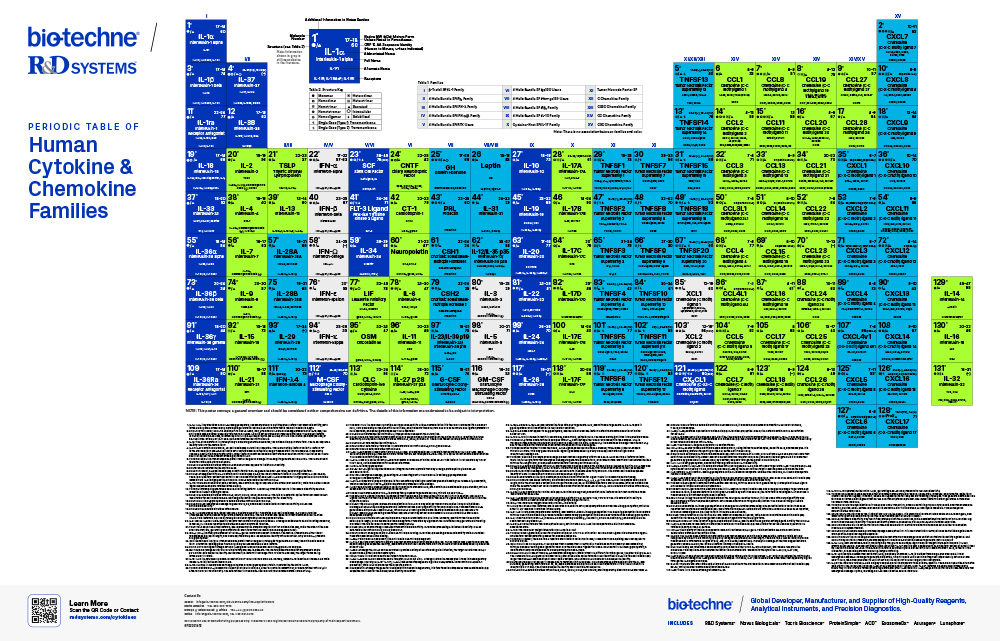The Periodic Table of Cytokine and Chemokine Families poster includes members of the tumor necrosis factor (TNF) superfamily, and cytokines belonging to the different families of interleukins, interferons, and chemokines. The families are color-coded and arranged in columns. Within each square, the full name of the cytokine is listed, along with its alternate names, a symbol to signify its structure, and the receptors that it utilizes to activate downstream signaling. Additionally, it is shown whether each cytokine belongs to the beta-trefoil, four helix bundle, or cysteine-knot superfamily and their subfamily designation.

On the far left-hand side of the poster, members of the IL-1 family are shown. All IL-1 family members share a conserved beta-trefoil structure and bind to members of the IL-1 receptor (IL-1 R) family. Members of the IL-1 R family contain extracellular Ig-like domains and mediate signaling through an intracellular Toll/IL-1 R (TIR) domain. Moving to the right, the next eight families shown in the poster belong to the four-helix bundle cytokine superfamily. This superfamily is further subdivided into the class I and class II cytokine receptor families. Ligands for the class I cytokine receptor family include short-chain and long-chain helical cytokines. The short-chain helical cytokine family includes members of the common gamma-chain and common beta-chain families of cytokines. The common beta-chain and common gamma-chain cytokine families include cytokines such as IL-2, IL-3, IL-4, IL-5, IL-7, IL-9, IL-15, IL-21, and GM-CSF, which are shown in columns two, three, and eight of the poster. Members of the common beta-chain family signal through heterodimeric receptor complexes that contain the common beta-chain subunit, while members of the common gamma-chain family signal through heterodimeric or heterotrimeric receptor complexes that contain the common gamma-chain subunit. The four short-chain helix bundle cytokines that signal through class III receptor tyrosine kinases include M-CSF, SCF, Flt-3 Ligand, and IL-34, and are shown in columns four and five of the poster. The receptors for these cytokines contain extracellular Ig-like domains, similar to the IL-1 R family, but they have cytoplasmic domains with tyrosine kinase activity. The long-chain helical cytokine family includes the IL-6 family cytokines, G-CSF, erythropoietin, thrombopoietin, growth hormone, prolactin, and leptin, which are shown in columns five through eight of the poster.
Ligands for the class II cytokine receptor family includes the IL-10 family cytokines, along with the type I, type II, and type III interferons, which are shown in columns three, four, and nine of the poster. Members of the IL-10 family cytokines have structural similarities and signal through heterodimeric receptor complexes with common subunits. Members of the type I, II, and III interferon families include IFN-alpha, IFN-beta, IFN-omega, IFN-epsilon, IFN-kappa, IFN-gamma, IL-28A, IL-28B, IL-29, and IFN-lambda4. These cytokines primarily have anti-viral, anti-proliferative, and immunoregulatory effects.
The final family of interleukins shown in the poster is the IL-17 family cytokines listed in column 10. These cytokines belong to the cysteine-knot superfamily and bind to members of the IL-17 receptor family. They are primarily involved in promoting pro-inflammatory immune responses.
Columns 11 through 13 in the poster show the members of the tumor necrosis factor (TNF) superfamily. Proteins in this family form homotrimers or in some cases, heterotrimers, and share a common extracellular domain known as the TNF homology domain (THD). Cytokines in the TNF superfamily bind to oligomeric, type I or type II transmembrane proteins that have multiple extracellular cysteine-rich domains. Many members of the TNF superfamily regulate apoptosis and/or immune cell functions, such as T cell co-stimulation, natural killer cell activation, and B cell homeostasis. Additionally, they can regulate cell type-specific responses and can play a significant role in regulating the pathogenesis of certain diseases, including chronic inflammation, cancer, and autoimmune diseases.
The final columns in the poster show proteins belonging to one of the four chemokine subfamilies. These subfamilies are known as the C, CX3C, CC, or CXC subfamilies, and are based on the number and spacing of conserved cysteine residues located in the amino-terminus. Chemokines bind to conventional G protein-coupled seven transmembrane receptors, with some promiscuity, and have a key role in regulating cell migration during development, and under homeostatic and inflammatory conditions.
Learn more about each of the members of these families by requesting our poster.